#mosasauroidea
Text
Dinofact #42
Apatosaurus's name means "deceptive lizard" in Greek. Othniel Charles Marsh gave the dinosaur this name because Apatosaurus's chevron bones resemble those of mosasaurs more than they do those of other dinosaurs.
Source: wikipedia
#dinosaur#dinosaurs#paleontology#apatosaurus#othniel charles marsh#othniel c. marsh#bones#mosasaurs#mosasaur#mosasauroidea#fun facts#trivia#dinosaur trivia#dinosaur fun facts#5th#october#2022#october 5th#october 2022#october 5th 2022
10 notes
·
View notes
Text
JORMUNGANDR WALHALLAENSIS: A NEW MOSASAURINE (SQUAMATA: MOSASAUROIDEA) FROM THE PIERRE SHALE FORMATION (PEMBINA MEMBER: MIDDLE CAMPANIAN) OF NORTH DAKOTA
Published 30th October 2023
A new genus and species of mosasaurine mosasaur is discovered, Jormungandr walhallaensis, from the Pierre Shale Formation in Cavalier County in North Dakota consisting of a partial skull and post cranial material.

Skull and jaws of the holotype specimen

Drawing of re-articulated skull from Jormungandr walhallaensis

Reconstruction of Jormungandr walhallaensis engaging in intraspecific combat, artwork by Henry Sharpe.
source:
(Sorry for not uploading for a while, i have been busy and taking some breaks. I will posting as usual now, thank you for your patience.)
43 notes
·
View notes
Photo
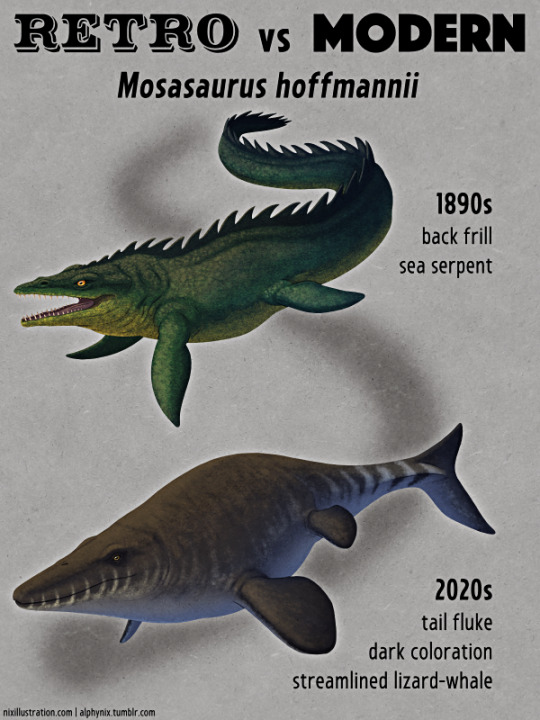
Retro vs Modern #07: Mosasaurus hoffmannii
The first scientifically documented mosasaur fossils were skulls discovered in the Netherlands during the 1760s and 1770s, but these remains were initially interpreted as belonging to a fish, crocodile, or whale. In the late 1790s their resemblance to monitor lizards was noted, and the fossils were soon recognized as belonging to giant marine reptiles unlike any known living species – a revolutionary concept at the time, and influential in the early development of ideas about extinction.
In the 1820s Mosasaurus hoffmannii was the first species officially described. For several decades it was thought to be a giant amphibious lizard with either webbed feet or flipper-like legs, with one of the earliest popular reconstructions being the 1850s Crystal Palace statue.
By the 1870s more complete fossil discoveries in North America had revealed the paddle-like flippers and fully aquatic nature of mosasaurs. Skin impressions showed overlapping keeled diamond-shaped scales resembling those of rattlesnakes, but proportionally much smaller compared to their body size.
1890s
Then, in the late 1890s, one mosasaur specimen was interpreted as having a mane-like "fringe" of soft tissue along its back.
Only a few years later this was realized to be a mistake, actually being preserved tracheal cartilage, but it was too late. The idea had already caught on in artistic depictions and quickly became a paleoart meme, with mosasaurs frequently portrayed with elaborate frills for the majority of the next century.
2020s
Early arguments about whether mosasaurs’ closest relatives were monitor lizards or snakes had settled down by the 1920s, with the consensus at the time being monitor lizards, and the first half of the 20th century saw little mosasaur research beyond the naming of a few new species. Much like the ichthyosaurs and plesiosaurs it was only really in the wake of the Dinosaur Renaissance that interest in these marine reptiles and their paleobiology really began to pick up again.
Rather than sea-serpent-like creatures we now recognize that mosasaurs actually looked more like lizards converging on whales or ichthyosaurs, with smooth streamlined bodies and vertical tail flukes. The size and shape of their scales varied across different parts of their bodies, parts of their bodies had dark coloration (likely with a countershaded pattern), and they probably had forked tongues.
They had a higher metabolic rate than most modern lizards, and may even have been warm-blooded. They probably also gave birth to live young, although a recently-discovered fossil soft-shelled egg found in Antarctica has been suggested to have come from a large mosasaur.
The debate about their evolutionary relationships has been reignited, too, with some recent studies once again supporting a very close relationship to snakes – although there's currently no clear consensus.
Our modern view of Mosasaurus hoffmannii is a large chunky mosasaur that grew to at least 11m long (~36'). It lived during the end of the Cretaceous period, about 70-66 million years ago, and inhabited a wide range of climates across much of the ancient Atlantic Ocean and various connected shallow seaways, with fossils known from Europe, Africa, and North and South America.
Its long jaws had a powerful bite force and it seems to have been a more visual hunter than some other mosasaurs, with relatively large eyes and a less well-developed sense of smell. It was one of the largest marine animals of its time and was probably a generalist apex predator, feeding on a wide variety of prey such as fish, ammonites, and other marine reptiles.
———
Nix Illustration | Tumblr | Twitter | Patreon
#retro vs modern 2022#science illustration#paleontology#paleoart#palaeoblr#mosasaurus#mosasauridae#mosasauroidea#mosasaur#squamata#lepidosauria#reptile#marine reptile#art#retrosaurs
1K notes
·
View notes
Text
Tylosaurus proriger, T. nepaeolicus, T. pembinensis, T. saskatchewanensis

Art by: RJ Palmer, https://www.deviantart.com/arvalis/art/Tylosaurus-768304483
Name: Tylosaurus proriger, T. nepaeolicus, T. pembinensis, T. saskatchewanensis
Name Meaning: Knob lizard
First Described: 1872
Described By: Marsh
Classification: Chordata, Tetrapoda, Reptilia, Squamata, Mosasauroidea, Mosasauridae, Tylosaurinae
Tylosaurus was an apex predator that patrolled the Western Interior Seaway of the Late Cretaceous. What’s really interesting about this mosasaur is that the very front tip of the jaws were toothless. It’s hypothesized that the absence of teeth in this part of the snout may have allowed it to act like a battering ram for Tylosaurus to shock and stun its prey during a hunt, similar to killer whales of today. I previously mentioned that Taniwhasaurus may have also used this same hunting strategy as well. A juvenile specimen of Tylosaurus was discovered in 2018, its snout greatly differed from other Tylosaurus juveniles which can tell us about the ontogeny of how juveniles had a quick development of snout projection over time. We know Tylosaurus was clearly an equal opportunity predator, as we see its stomach contents which included a plesiosaur, other much smaller mosasaurs, Hesperornis, sharks, fish, and we even see teeth marks which we suspect came from Tylosaurus on a Hadrosaur carcass that was washed out to sea.
Sources:
https://en.wikipedia.org/wiki/Tylosaurus
#Tylosaurus#palaeoblr#paleontology#palaeontology#prehistoric#Mesozoic#ancient marine reptiles#Not a dinosaur#mosasauroidea
67 notes
·
View notes
Note
Do you make any other fish?
Here is a list of all fish I make currently, in no particular order:
Actinopterygii - Ray finned fish
SiluriformesCorydoras pygmaeusCorydoras sterbaiCorydoras aeneusOtocinclus sp.
PerciformesBetta splendens-Cichlids (coming soon)Mikrogeophagus ramireziCichlasoma festaeCynotilapia afraPseudotropheus saulosiThorichthys meekiGeophagus sp.
Polypteriformes (coming soon)Polypterus palmas
Sarcopterygii- Lobe Finned Fish
TetrapodomorphaTiktaalik roseae
-SauropterygiaPliosaurus funkeiPliosaurus kevaniPlesiosaurus dolichodeirus-MosasauroideaTylosaurus proriger
-IchthyosauriaIchthyosaurus communisStenopterygius sp.Temnodontosaurus platyodon
-CrocodylomorphsMetriorhynchus superciliosus
-Pterosauria Quetzalcoatlus (in hiatus)Rhamphorhynchus (in hiatus)
-DinosauriaCitipati osmolskaeVelociraptor mongoliensis (in hiatus)Dakotaraptor (Saurian backer exclusive)Archaeopteryx (Kickstarter!)Brachiosaurus (in hiatus)Microraptor (in hiatus)
-MammaliaThylacinus cynocephalus (Coming soon)
There’s probably a bunch more I’ve forgotten but these are all the “official” Palaeoplushies I’ve made up to this point. I was going to stop when I reached Tiktaalik but I like Tetrapod fish too much.
16 notes
·
View notes
Text
Yaguarasaurus columbianus

Art by: HodariNundu, https://www.deviantart.com/hodarinundu/art/Diving-with-Yaguarasaurus-787132280
Name: Yaguarasaurus columbianus
Name Meaning: Yaguará lizard
First Described: 1994
Described By: Páramo
Classification: Chordata, Tetrapoda, Reptilia, Squamata, Mosasauridae, Yaguarasaurinae
Yaguarasaurus was a Late Cretaceous primitive mosasauroid discovered in Colombia’s La Frontera Formation. Paleontologists unearthed some ribs, vertebrae and the skull. This mosasaur is closely related to Tethysaurus and Russellosaurus and make up the subfamily Tethysaurinae.
Sources:
http://www.prehistoric-wildlife.com/species/y/yaguarasaurus.html
https://en.wikipedia.org/wiki/Yaguarasaurus
#Yaguarasaurus#palaeoblr#paleontology#palaeontology#prehistoric#Mesozoic#ancient marine reptiles#Not a dinosaur#mosasauroidea
44 notes
·
View notes
Text
Phosphorosaurus ortliebi, P. ponpetelegans
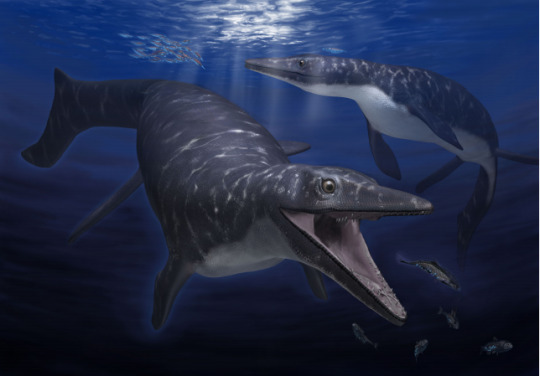
Art by: Tatsuya Shinmura, Ashoro Museum of Paleontology
Name: Phosphorosaurus ortliebi, P. ponpetelegans
Name Meaning: Phosphate lizard
First Described: 1889
Described By: Dollo
Classification: Chordata, Tetrapoda, Reptilia, Squamata, Mosasauridae, Halisaurinae
Phosphorosaurus lived during the Maastrichtian of the Late Cretaceous. Being a part of the Halisaurinae subfamily most likely means that Phosphorosaurus also had primitive characteristics such as poorly developed flippers. In 2015, a new species, Phosphorosaurus ponpetelegans was found in Japan’s Pankerusano-sawa Creek and this discovery was eye opening because this mosasaur most likely hunted in deep dark waters, through the help of its binocular vision (front facing eyes). Basically, you could make eye contact with P. ponpetelegans, as other mosasaurs that we currently know of do not have binocular vision. Anyways, P. ponpetelegans may have waited to ambush bioluminescent prey, as it wasn’t the greatest swimmer due to its flippers. It also may have developed this hunting strategy to avoid competition with other local mosasaurs in the ecosystem.
Sources:
https://en.wikipedia.org/wiki/Phosphorosaurus
#Phosphorosaurus#palaeoblr#paleontology#palaeontology#prehistoric#mesozoic#Ancient Marine Reptiles#Not a dinosaur#mosasauroidea
74 notes
·
View notes
Text
Prognathodon curri, P. giganteus, P. hashimi, P. hudae, P. lutugini, P. solvayi

Art by: Dmitry Bogdanov, Public Domain
Name: Prognathodon curri, P. giganteus, P. hashimi, P. hudae, P. lutugini, P. solvayi
Name Meaning: Forejaw tooth
First Described: 1889
Described By: Dollo
Classification: Chordata, Tetrapoda, Reptilia, Squamata, Mosasauroidea, Mosasauridae, Mosasaurinae
Prognathodon existed during the Late Cretaceous and it has been discovered in Europe, North America, and the Middle East. This mosasaur had powerful jaws that were clearly made for crushing and based on its dentition, it most likely consumed hard shelled prey such as ammonites, turtles, and etc. There is actually a specimen of Prognathodon where its stomach contents included a turtle along with an ammonite. There are multiple species of Prognathodon that are still currently disputed such as: P. kianda, P. overtoni, P. rapax, P. saturator, P. stadtmani, P. waiparaensis. A specimen was found from Jordan, with a preserved outline of soft tissue which revealed that mosasaurs had a hypocercal tail.
Sources:
http://www.prehistoric-wildlife.com/species/p/prognathodon.html
https://en.wikipedia.org/wiki/Prognathodon
#Prognathodon#palaeoblr#paleontology#palaeontology#prehistoric#Mesozoic#ancient marine reptiles#Not a dinosaur#mosasauroidea
45 notes
·
View notes
Text
Tethysaurus nopcsai

Art by: Julio Lacerda, @paleoart
Name: Tethysaurus nopcsai
Name Meaning: Tethys lizard
First Described: 2003
Described By: Bardet, Pereda-Suberbiola & Jalil
Classification: Chordata, Tetrapoda, Reptilia, Squamata, Mosasauridae, Tethysaurinae
Tethysaurus was a primitive mosasaur from the Late Cretaceous. It was discovered in Morocco in Northern Africa. This mosasaur had characteristics seen in both primitive and derived mosasaurs. The specimen found had a fairly complete post cranial body in addition to its complete skull. It is closely related to Russellosaurus and Yaguarasaurus.
Sources:
http://www.prehistoric-wildlife.com/species/t/tethysaurus.html
https://en.wikipedia.org/wiki/Tethysaurus
#Tethysaurus#palaeoblr#paleontology#palaeontology#prehistoric#Mesozoic#ancient marine reptiles#Not a dinosaur#mosasauroidea
28 notes
·
View notes
Text
Taniwhasaurus oweni, T. antarcticus, T. mikasaensis
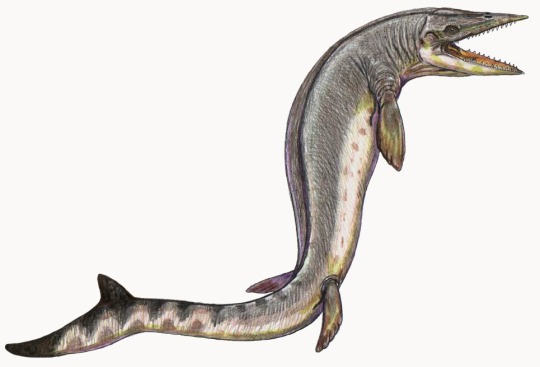
Art by: Dmitry Bogdanov, Public Domain
Name: Taniwhasaurus oweni, T. antarcticus, T. mikasaensis
Name Meaning: Taniwha lizard, from Māori Taniwha, an aquatic supernatural being
First Described: 1874
Described By: Hector
Classification: Chordata, Tetrapoda, Reptilia, Squamata, Mosasauridae, Tylosaurinae
This mosasaur was found in New Zealand, Antarctica, and Japan. It’s closely related to Hainosaurus, who I have covered in a previous post, and also Tylosaurus who will be covered shortly. The very front tip of the jaws of Taniwhasaurus actually were toothless, no teeth at all. This interestingly infer that Taniwhasaurus may have used its frontal jaws like a battering ram in order to ram into its prey during a kill. This tactic of hunting is similar to what modern marine animals such as killer whales use to stun their victims during an attack. In addition, Taniwhasaurus may have been a generalist that fed and hunted whatever it could take down.
Sources:
http://www.prehistoric-wildlife.com/species/t/taniwhasaurus.html
https://en.wikipedia.org/wiki/Taniwhasaurus
#Taniwhasaurus#palaeoblr#paleontology#palaeontology#prehistoric#Mesozoic#ancient marine reptiles#Not a dinosaur#mosasauroidea
27 notes
·
View notes
Text
Vallecillosaurus donrobertoi

Art by: Karkemish [CC BY 3.0 (https://creativecommons.org/licenses/by/3.0)]
Name: Vallecillosaurus donrobertoi
Name Meaning: After the village of Vallecillo, Nuevo Leon State in Mexico
First Described: 2008
Described By: Smith & Buchy
Classification: Chordata, Tetrapoda, Reptilia, Squamata, Mosasauroidea
Vallecillosaurus was a primitive mosasaur discovered from Mexico’s Agua Nueva Formation, dating back to the Late Cretaceous. Vallecillosaurus was a basal mosasaur, even its limbs suggests that it wasn’t completely adapted to a fully marine lifestyle; the limbs weren’t paddle-like as seen in later derived mosasaurs. Even though Vallecillosaurus was discovered with incomplete remains, what’s really cool is that we actually have skin impressions from this animal! The scales were preserved with a rhomboidal shape. We can make a comparison between Vallecillosaurus scales and the scales found preserved with Platecarpus, who had variation of scales on different portions of its body. Anyways, little rocks were found with Vallecillosaurus, which possibly infers that it may have used these rocks to help it achieve neutral buoyancy and act as ballasts to avoid constantly floating towards the surface and stay submerged. Also, it could’ve used these rocks as digestive aids to grind its meals.
Sources:
http://www.paleofile.com/Lizards/Vallecillosaurus.asp
http://www.prehistoric-wildlife.com/species/v/vallecillosaurus.html
https://en.wikipedia.org/wiki/Vallecillosaurus
#Vallecillosaurus#palaeoblr#paleontology#palaeontology#Mesozoic#ancient marine reptiles#not a dinosaur#mosasauroidea
18 notes
·
View notes
Text
Plioplatecarpus marshi, P. depressus, P. primaevus, P. houzeaui, P. peckensis
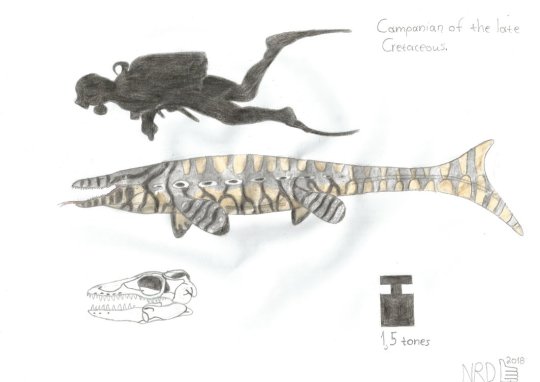
Art by: Nick-Rafael Danis, https://www.deviantart.com/nrd23456/art/Plioplatecarpus-primaevus-740369798
Name: Plioplatecarpus marshi, P. depressus, P. primaevus, P. houzeaui, P. peckensis
Name Meaning: More Platecarpus (More flat wrist)
First Described: 1882
Described By: Dollo
Classification: Chordata, Tetrapoda, Reptilia, Squamata, Mosasauridae, Plioplatecarpinae
Plioplatecarpus had large eyes for a mosasaur. The development of big eyes may be an adaptation to see better in deeper and murky waters, this adaptation is typically seen in Ichthyosaurs. The amount of teeth within Plioplatecarpus suggest that it may have specialized in hunting smaller sized prey. Anyways, Plioplatecarpus lived in North America’s Western Interior Seaway and in addition, it had fossils discovered in The Netherlands and in Sweden as well.
Sources:
http://www.prehistoric-wildlife.com/species/p/plioplatecarpus.html
https://en.wikipedia.org/wiki/Plioplatecarpus
#plioplatecarpus#palaeoblr#paleontology#palaeontology#prehistoric#mesozoic#ancient marine reptiles#not a dinosaur#mosasauroidea
33 notes
·
View notes
Text
Plesiotylosaurus crassidens
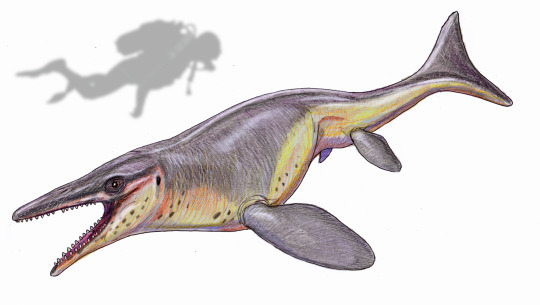
Art by: Dmitry Bogdanov, CC BY-SA 4.0
Name: Plesiotylosaurus crassidens
Name Meaning: Near Tylosaurus
First Described: 1942
Described By: Camp
Classification: Chordata, Tetrapoda, Reptilia, Squamata, Mosasauridae, Mosasaurinae
Plesiotylosaurus lived during the Late Cretaceous. It was discovered in California’s Moreno Formation. This mosasaur is not closely related to Tylosaurus, as its generic name may cause one to think. However, Plesiotylosaurus may possibly have convergently evolved similarly to tylosaurine mosasaurs due to some unique characteristics shared in their skulls.
Sources:
http://www.prehistoric-wildlife.com/species/p/plesiotylosaurus.html
https://en.wikipedia.org/wiki/Plesiotylosaurus
#Plesiotylosaurus#palaeoblr#Paleontology#palaeontology#prehistoric#Mesozoic#ancient marine reptiles#not a dinosaur#mosasauroidea
23 notes
·
View notes
Text
Pontosaurus lesinensis, P. kornhuberi

Photo by: Ghedoghedo [CC BY-SA 3.0 (https://creativecommons.org/licenses/by-sa/3.0)], from Wikimedia Commons
Name: Pontosaurus lesinensis, P. kornhuberi
First Described: 1892
Described By: Gorjanovic-Kramberger
Classification: Chordata, Tetrapoda, Reptilia, Squamata, Anguimorpha, Pythonomorpha
Pontosaurus was a semi-aquatic reptile that lived during the Late Cretaceous, and was discovered in Croatia and Lebanon. Two species have been discovered, and P. lesinensis was initially called Hydrosaurus until it was realized that the name was already taken by a lizard from the Agamidae family. Pontosaurus is apart of the clade Pythonomorpha, which was created by Cope in 1869. Cope proposed this clade in order to account for the possible relationship between snakes and mosasaurs. There’s still a debate on the relationship between mosasaurs, snakes, and even monitor lizards.
Sources:
http://www.prehistoric-wildlife.com/species/p/pontosaurus.html
https://en.wikipedia.org/wiki/Pontosaurus
https://en.wikipedia.org/wiki/Pythonomorpha
#Pontosaurus#palaeoblr#paleontology#palaeontology#prehistoric#Mesozoic#ancient marine reptiles#Not a dinosaur#mosasauroidea
23 notes
·
View notes
Text
Plotosaurus bennisoni, P. tuckeri
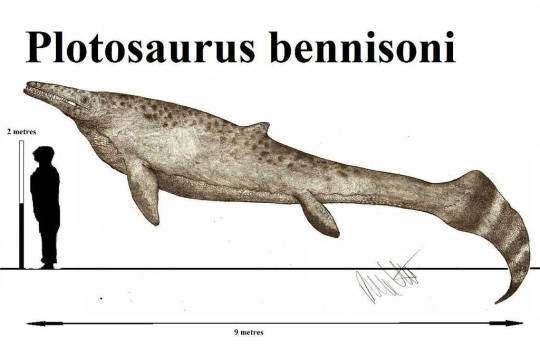
Art by: Robinson Kunz, https://www.deviantart.com/teratophoneus/art/Plotosaurus-bennisoni-645366517
Name: Plotosaurus bennisoni, P. tuckeri
Name Meaning: Swimmer lizard
First Described: 1951
Described By: Camp
Classification: Chordata, Tetrapoda, Reptilia, Squamata, Mosasauridae, Mosasaurinae
Plotosaurus, so far is the most derived mosasaur that paleontologists have come across. Plotosaurus was very derived because it had unique characteristics not seen in other mosasaurs. They had increased hyperphalangy in their flippers, powerful tail, and a streamlined body in which many speculate that it may have had a dorsal fin on its back. Plotosaurus also had big eyes as well. As you can see, they were evolving an ichthyosaur-like body plan as they began to dwell into deeper waters. I hypothesize that had the Cretaceous-Paleogene (K-Pg) Extinction not happened, maybe mosasaurs would’ve become more ichthyosaur-like in their appearance. Also, Plotosaurus specimens were found with scaly skin impressions, which further provides evidence that mosasaurs retained their scales and did not lose them over time while keeping their aquatic lifestyle.
Sources:
Lindgren, J., Jagt, J.W.M., and Caldwell, M.W. 2007. A fishy mosasaur: the axial skeleton of Plotosaurus (Reptilia, Squamata) reassessed. Lethaia 40:153-160.
Lindgren, J., Alwmark, C., Caldwell, M.W., and Fiorillo, A.R. 2009. Skin of the Cretaceous mosasaur Plotosaurus: implications for aquatic adaptations in giant marine reptiles. Biology Letters doi:10.1098/rsbl.2009.0097
http://www.prehistoric-wildlife.com/species/p/plotosaurus.html
https://en.wikipedia.org/wiki/Plotosaurus
#Plotosaurus#palaeoblr#paleontology#palaeontology#prehistoric#Mesozoic#ancient marine reptiles#Not a dinosaur#mosasauroidea
21 notes
·
View notes
Text
Plesioplatecarpus planifrons

Art by: Slate Weasel [Public domain], from Wikimedia Commons
Name: Plesioplatecarpus planifrons
Name Meaning: Near Platecarpus
First Described: 2011
Described By: Konishi & Caldwell
Classification: Chordata, Tetrapoda, Reptilia, Squamata, Mosasauridae, Plioplatecarpinae, Plioplatecarpini
Plesioplatecarpus existed during the Late Cretaceous. You could catch this Plioplatecarpine mosasaur patrolling the waters of the Western Interior Seaway and the Gulf of Mexico. Cope originally described Plesioplatecarpus as a species of Clidastes and it was then later thought to be a species of Platecarpus. You can see the wastebasket taxonomy striking again, until 2011, Takuya Konishi and Michael Caldwell determined that Plesioplatecarpus was definitely unique on its own and could be distinguished from Platecarpus.
Sources:
http://www.prehistoric-wildlife.com/species/p/plesioplatecarpus.html
https://en.wikipedia.org/wiki/Plesioplatecarpus
#Plesioplatecarpus#palaeoblr#paleontology#palaeontology#prehistoric#mesozoic#ancient marine reptiles#Not a dinosaur#mosasauroidea
24 notes
·
View notes